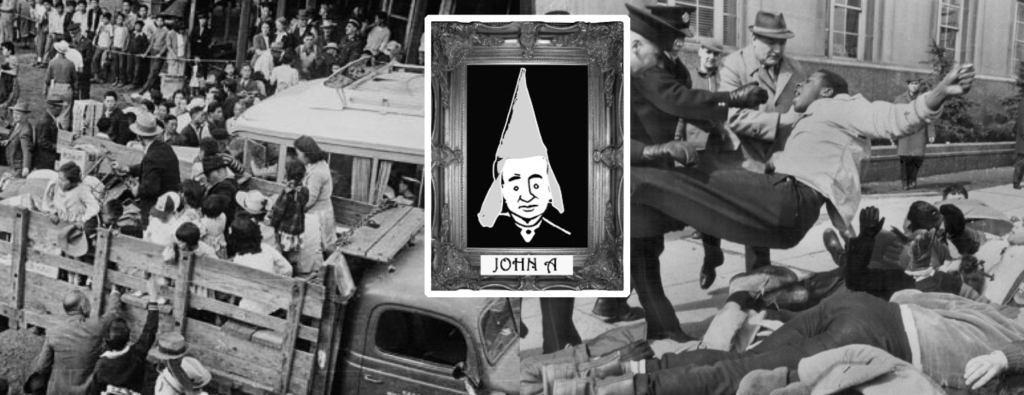By Brendan Campisi
This article was originally published in the 20th issue of Rebel Youth (2016)
In today’s debates over the admission of Syrian refugees to Canada, many defenders of admission, including the Trudeau Liberals, have drawn on the image of Canada as a friendly, welcoming country with a history of accepting refugees and immigrants. While this flattering cliché is believed by many Canadians, a look at the history of this country’s immigration policy shows it is far from the truth.
Early Canadian immigration law was loose to the point of being almost non-existent, befitting a settler-colonial society founded on European migration. This began to change when the first major group of non-European immigrants arrived in the 1870s and 80s. This group was made up of Chinese immigrants who mostly settled in British Columbia, many after working in deadly conditions building the Canadian Pacific Railroad. Calls began to limit this influx and by the early 1880s the ‘head tax’ had been introduced to discourage Chinese immigration. It would be raised significantly several times, eventually becoming so high that it effectively ended Chinese migration entirely. Chinese people were also stripped of the right to vote at the same time. In the discussion of that law, John A MacDonald said that it was necessary to disenfranchise the Chinese and stop them from immigrating in order to preserve “the Aryan character of the future of British North America.”
Over the late 19th and early 20th centuries, measures were introduced to keep other non-European groups besides the Chinese out. African-Americans were discouraged from coming to Canada on the pretext that they wouldn’t be able to handle the cold. A law mandating that immigrants take an ‘uninterrupted voyage’ was used to exclude Indians, who as British subjects should legally have been able to migrate freely. In 1914 the Komagata Maru, a ship filled with would-be immigrants from Punjab, was forcibly turned away from Vancouver. Beginning with the Laurier government, Canada established a three-tiered hierarchy of prospective immigrants: British, Anglo-American and Western European immigrants were preferred; Southern and Eastern Europeans were non-preferred but permitted, especially when capital needed cheap labour; and non-Europeans were excluded entirely.
“White Canada” became an untouchable pillar of bourgeois politics, with Liberals and Conservatives alike trumpeting their commitment to racial exclusion. The social-democratic CCF was more sympathetic to the plight of European immigrants but even they rejected ‘opening the gates’ to people of colour. In the 1930s immigration to Canada virtually stopped. Canada’s refusal during those years to take in Jewish refugees fleeing the rise of fascism, condemning unknown numbers of people to their deaths, contrasts sharply with the image later created of a welcoming country.
The defeat of fascism in the Second World War discredited the kind of virulent biological racism which had justified both Nazism’s crimes and the ‘White Canada’ policy. The socialist countries challenged the West on its racism, and the beginning of decolonization also put pressure on the imperialist countries to at least improve their image on issues of racism and discrimination. Immigrant communities, labour and progressive forces in Canada increasingly pressured the government to end discrimination in immigration policy. In 1947, the Chinese Exclusion Act was repealed. In the speech to parliament announcing this, however, Mackenzie King made it clear discrimination was not over. He said that it was “not a ‘fundamental human right’ of any alien to enter Canada,” and that Canadians rejected “large-scale immigration from the Orient” which would “change the fundamental composition of the Canadian population.” Canadian immigration policy over the next few decades was shaped by the effort, in the words of one government document, “to avoid the charge of discrimination” while “preventing an aggravation of the minority problem” by maintaining racial exclusion.
In the 1950s and 60s explicit racism was replaced by restrictions on the basis of ‘assimilability’ and ‘suitability for Canadian life.’ The minister of immigration had the authority to bar any group on this basis, and through to the early 1960s it was used to continue to exclude virtually all non-European migrants, particularly Asians. In 1962 the Diefenbaker government, embarrassed by critics who pointed out the hypocrisy of its criticisms of Apartheid South Africa while Canada’s racist immigration policy remained in place, implemented a significant change in policy which introduced a new emphasis on immigrant’s skills and explicitly moved away from formal discrimination. However, under these new rules it was still easier for European immigrants to sponsor relatives than non-European ones, and active recruitment of immigrants remained confined to the traditional preferred nations. The new rules ultimately changed very little in concrete terms. Racist ideology remained deeply entrenched in the immigration bureaucracy. The acting head of the department wrote in 1963 that policy was based on “the premise that immigration should help maintain the essentially occidental character of the Canadian population,” echoing Mackenzie King or MacDonald. Other officials in the mid-60s argued that sponsorship should be formally opened up but educational requirements for those sponsored should be introduced, targeted at non-Europeans—reminiscent of the ‘literacy tests’ that kept Black people from voting in the Jim Crow South.
By the end of the 1960s the wave of South and Eastern European immigration which had supplied the cheap labour for Canada’s postwar economic expansion had run out. This along with continuing pressure from immigrant communities ultimately led to the introduction of the ‘points system’, ending formal racial and national discrimination in Canadian immigration policy. Of course this did not really mean the end of racism or discrimination, either for prospective immigrants to Canada or for their-Canadian born descendants. In our own time state surveillance and repression of Muslim communities, panics about ‘human trafficking’ and undocumented migrants, detentions and deportations serve to remind us that White Canada was never really ended, and that the racist capitalist state will not end it on its own.

